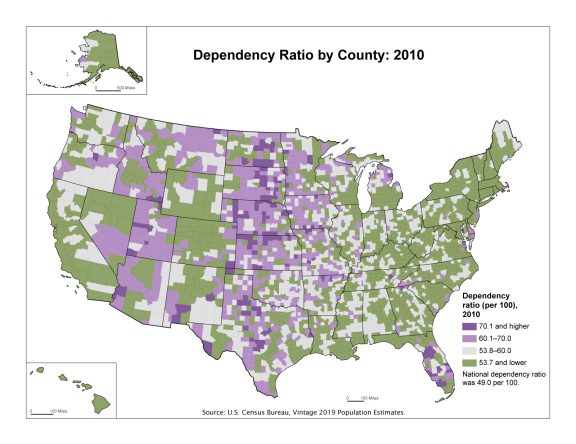WASHINGTON – The surge in the number of Americans aged 65 and older this decade has outpaced the growth in the working-age population.
In counties across the United States, the dependency ratio has increased, according to U.S. Census Bureau population estimates released today.
Over the last decade, the growth of the non-working-age (dependent) population – ages 0 to 14 and 65 and older – has outpaced the growth of the working-age population.
A dependency ratio looks at the size of the population under the age of 15 (60,570,846 in 2019) and the 65-and-older population (54,058,263) and how their combined size compares to the population aged 15 to 64 (213,610,414).
America’s population is aging. Since 2010, there has been a sizable 34% increase in the 65-and-older population, a growth of approximately 13.8 million people.
During this period, the median age (the age at which half the population is younger and half is older) also increased from 37.2 to 38.4 years. In 2019, more than half the states had a median age greater than 38.4.
Every state in the Northeast had a median age higher than that of the nation.
Along with increased aging, there have been changes in the population’s age structure. Most notably: the growth of the 65-and-older population and the shrinking of the population aged 14 and under.
The aging of baby boomers, those born between 1946 and 1964, who were aged 55 to 73 in 2019, is partly driving the growth in the older population. The slow decline of the younger population, which has decreased by 657,000 people (1.1%) since 2010, is in part due to a general decrease in fertility, ongoing since 2007.
An interesting pattern emerges when comparing changes in the younger population, older population and the working-age population (those aged 15 to 64) between 2010 and 2019.
Over the last decade, the growth of the non-working-age (dependent) population – those aged 0 to 14 and 65 and older – has outpaced the growth of the working-age population.
The non-working-age population grew by 13.1 million, a 12.9% increase, while the working-age population increased by a modest 6.4 million or 3.1%.
Two maps highlight this shift by showing the dependency ratio in counties across the nation.
A lower ratio means there are fewer dependent-age people relative to the size of the working-age population. In contrast, a higher ratio indicates there are more dependent-age people relative to those of working age.
In 2010, the dependency ratio for the nation as a whole was 49.0, meaning that for every 100 working-age people there were 49 dependent-age people. By 2019, this dependency ratio increased to 53.7, driven by the growth of the 65-and-older population.
The geographic patterns and magnitude of change in dependency ratios are varied. In 2010, the ratios were highest in the Great Plains and parts of Florida. Still, numerous counties in 2010 had dependency ratios lower than the 2019 national ratio.

By 2019, high dependency ratios were more widespread. Fewer counties had dependency ratios lower than that of the nation, and many of those counties were in or near metropolitan areas.

Dependency ratios offer a unique way of looking at the impact of the nation’s aging since 2010 and insights into how America will change in the future.









